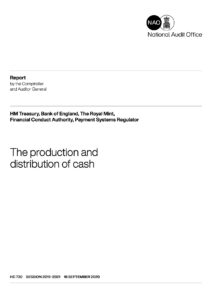22 September 2020: Physical cash use is declining fast, leaving the fixed cost base for processing cash transactions at risk of stranding. As cards and digital forms of payment become more prevalent, what will happen to those who still need access to cash?
The National Audit Office (NAO) issued a report on 18 September 2020 on the production and distribution of cash. It looks at what the Bank of England, the Royal Mint, HM Treasury and financial regulators are doing in response to a 59% decline in the volume of cash transactions between 2008 and 2019, as well as efforts to improve the efficiency of cash production and reduce counterfeiting.
According to data from UK Finance, cash payment values fell from £267bn in 2008 to £141bn in 2019 and were (prior to the pandemic) forecast to fall to £59bn by 2028.
Coin production has fallen significantly, with 383m coins manufactured for circulation in 2019-20 compared with 1.1bn in 2010-11. Notes in circulation have continued to increase (to 4.4bn notes with a monetary value of £76.5bn in July 2020), but only around 20%-24% of these are used for cash transactions and 5% used for savings, leaving over £50bn whose location is uncertain – a point which the NAO believes deserves further investigation.
A key finding from the report is that there is no single body in government responsible for overseeing how well the cash system is performing, despite the establishment of a Joint Authorities Cash Strategy Group (JCAS) focused on access to cash for those that need it, in particular for the million or so UK adults who do not have a bank or building society account.
The UK’s entire cash infrastructure across the public and private sectors is estimated to cost around £5bn a year, with many of these being fixed costs that with declining usage are putting pressure on the cash system.
The number of ATMs fell by 12% over the two years to December 2019 to around 60,000, with a fall of 17% in the number that were free-to-use to around 45,000. The Payment Systems Regulator (PSR) has been working with the industry to maintain free-to-use ATMs in geographic areas where provision is most limited, although the NAO recommends greater attention is given to more deprived areas.
Demand for notes and coins declined by 71% between early-March and mid-April 2020 during the COVID-19 lockdown but has since recovered. The NAO believes it is still too early to assess the longer-term impact on cash access and usage but moves amongst some retailers to suspend acceptance of cash during the pandemic could further accelerate the switch to non-cash forms of payment.
The NAO is positive about the steps the Royal Mint and the Bank of England have taken against counterfeiting. In 2016, about one in 30 £1 coins was a counterfeit, but surveys since 2018 have found very low counterfeiting rates for the new £1 coin. The introduction of the polymer £20 note, traditionally the denomination favoured by counterfeiters, should also help reduce the cost of fraud to consumers and businesses.
The Royal Mint reported a reduced loss of £3.9m on its coin-making activities in 2019-20, with actions to improve efficiency including a 22% headcount reduction within its currency division and the mothballing of two of its six plating lines. The Bank of England has also worked with De La Rue to improve efficiency, albeit each polymer banknote costs 60% to 80% more than a paper one, even if they are expected to last at least 2.5 times longer.
The NAO recommends that HM Treasury takes another look at the roles and responsibilities of the bodies involved in the cash system, setting out more clearly the specific outcomes it wants to deliver for consumers and small businesses and how this should be balanced against the cost of doing so. It also believes that a plan is needed to take action if some groups become left behind as the cash system changes.
Martin Wheatcroft FCA, adviser to ICAEW on public finances, commented: “The NAO has provided some extremely useful insights into how the UK’s cash system is coping with declining usage and it makes a number of sensible recommendations for improvements.
“However,” continued Wheatcroft, “the report does not answer the more fundamental issue of whether cash has a long-term future at all, and in particular whether the multi-billion costs of running cash and other legacy payment systems could be better deployed.
“Ultimately, is it now time to look beyond a managed decline of the cash system and explore more radical options?”
